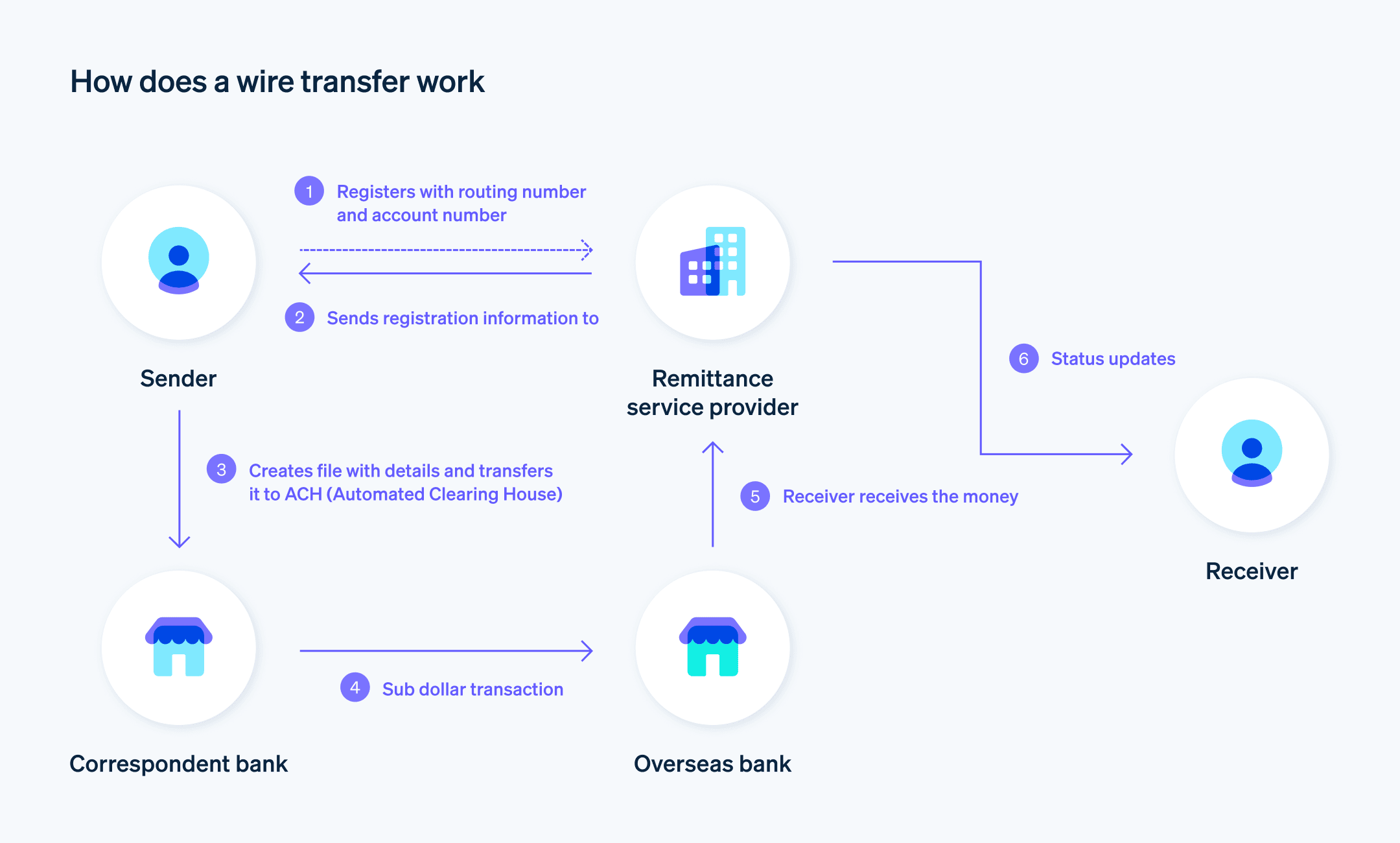การโอนเงินระหว่างธนาคารเป็นวิธีการส่งเงินระหว่าง 2 ฝ่ายที่ได้รับความนิยม ในปี 2024 มีการส่งการโอนเงินระหว่างธนาคารมากกว่า 200 ล้านรายการในสหรัฐอเมริกา โดยเป็นอัตราที่เพิ่มขึ้น 9% เมื่อเทียบกับปีก่อนหน้า หากจะพิจารณาว่าการโอนเงินระหว่างธนาคารควรเป็นส่วนหนึ่งของกลยุทธ์การส่งและรับเงินของธุรกิจคุณหรือไม่ นี่คือสิ่งที่คุณต้องรู้เกี่ยวกับวิธีการทำงานของการโอนเงินระหว่างธนาคาร รวมถึงข้อดีข้อเสียที่อาจมีต่อธุรกิจของคุณ
บทความนี้ให้ข้อมูลอะไรบ้าง
- การโอนเงินระหว่างธนาคารคืออะไร
- การโอนเงินระหว่างธนาคารมีวิธีการทำงานอย่างไร
- การโอนเงินระหว่างธนาคารเทียบกับการโอนเงินแบบ ACH
- การโอนเงินระหว่างธนาคารระหว่างประเทศ
- การโอนเงินระหว่างธนาคารใช้เวลานานเท่าใด
- การโอนเงินระหว่างธนาคารปลอดภัยหรือไม่
- การโอนเงินระหว่างธนาคารสามารถปรับคืนหรือยกเลิกได้หรือไม่
- ค่าธรรมเนียมการโอนเงินระหว่างธนาคาร
- ข้อดีข้อเสียของการโอนเงินระหว่างธนาคารสำหรับธุรกิจ
- Stripe จะช่วยได้อย่างไร
การโอนเงินระหว่างธนาคารคืออะไร
การโอนเงินระหว่างธนาคารคือวิธีการย้ายเงินทางอิเล็กทรอนิกส์จากฝ่ายหนึ่งไปยังอีกฝ่ายหนึ่ง โดยอาจส่งระหว่างบัญชีธนาคารสองบัญชีโดยตรง หรือจากบุคคลทั่วไปไปให้บุคคลอื่น การโอนเงินระหว่างธนาคารใช้บริการโอนเงินระหว่างธนาคารภายนอกที่ไม่ใช่ธนาคาร เช่น MoneyGram หรือ Western Union การโอนเงินระหว่างธนาคารเป็นวิธีการโอนย้ายเงินภายในประเทศและระหว่างประเทศที่รวดเร็ว เชื่อถือได้ และปลอดภัย
การโอนเงินระหว่างธนาคารมีวิธีการทำงานอย่างไร
ในการโอนเงินระหว่างธนาคารกับธนาคารทั่วไป ระบบจะส่งเงินทุนผ่านเครือข่ายโอนเงินระหว่างธนาคาร ในสหรัฐอเมริกา ธนาคารกลางจะจัดการ Federal Reserve Wire Network (เรียกกันว่า Fedwire) ที่ธนาคารใช้ส่งและรับเงิน Fedwire เป็นระบบการชําระเงินแบบเรียลไทม์ของธนาคารกลางซึ่งอำนวยความสะดวกทางอิเล็กทรอนิกส์ในการทำธุรกรรมระหว่างสถาบันทางการเงิน ทั้งธุรกิจ, ผู้บริโภค, ธนาคาร และหน่วยงานรัฐต่างใช้เครือข่ายนี้ในการโอนเงินอย่างปลอดภัยและรวดเร็ว
การโอนเงินระหว่างธนาคารเป็นที่นิยมเนื่องจากความสะดวกและความรวดเร็ว และ Fedwire ก็จัดการปริมาณการโอนเงินจำนวนมาก ในปี 2024 มีการโอนเงินเฉลี่ยมากกว่า 800,000 ครั้งต่อวัน
เจ้าของบัญชีสามารถเริ่มโอนเงินระหว่างธนาคารผ่านสถาบันธนาคารของตัวเองได้โดยตรง หากต้องการโอนเงินระหว่างธนาคาร ผู้ส่งจะต้องให้ข้อมูลต่อไปนี้
- หมายเลขบัญชีธนาคารและ ABA Routing Number ของผู้ส่ง
- ชื่อของผู้รับ
- ชื่อธนาคารของผู้รับ
- หมายเลขบัญชีธนาคารของผู้รับและ ABA Routing Number
- ที่อยู่ของผู้รับ
- จำนวนเงินที่จะส่ง
เนื่องจากธนาคารจะอนุมัติการโอนเงินก็ต่อเมื่อเงินที่พร้อมใช้งานครอบคลุมจำนวนเงินดังกล่าว ผู้รับจึงไม่ต้องรออนุมัติ ในกรณีส่วนใหญ่ การโอนเงินระหว่างธนาคารภายในประเทศจะออกจากบัญชีของคุณในวันเดียวกับที่คุณส่งคำขอให้โอนเงิน

การโอนเงินระหว่างธนาคารเทียบกับการโอนเงินแบบ ACH
การโอนเงินระหว่างธนาคารและการโอนเงินแบบ ACH เป็นประเภทการโอนเงินทางอิเล็กทรอนิกส์ (EFT) ที่ได้รับความนิยมซึ่งส่งและรับเงินโดยไม่ต้องใช้เงินกระดาษ เช็คใบจริง หรือบัตรเครดิต ทั้งสองวิธีใช้เครือข่ายของบุคคลที่สามเพื่อโอนย้ายเงินระหว่างบัญชีในสถาบันทางการเงินต่างๆ
แต่การโอนเงินระหว่างธนาคารและการโอนเงินแบบ ACH นั้นไม่สามารถใช้แทนกันได้และมีความแตกต่างที่สำคัญๆ ดังต่อไปนี้
1. ใช้เครือข่ายที่แตกต่างกัน
การโอนเงินแบบ ACH จะส่งเงินระหว่างบัญชีโดยใช้สำนักหักบัญชีอัตโนมัติ (ACH) ซึ่งเป็นเครือข่ายทางการเงินในสหรัฐอเมริกาที่รวมศูนย์ ดูแลโดย National Automated Clearing House Association (Nacha) ซึ่งเป็นองค์กรอิสระที่มีเจ้าของเป็นธนาคาร สหภาพเครดิต และบริษัทประมวลผลการชําระเงินกลุ่มใหญ่ ในทางกลับกัน การโอนเงินระหว่างธนาคารจะดําเนินการผ่าน Fedwire
2. การโอนเงินระหว่างธนาคารมักจะเร็วกว่า
การโอนเงินระหว่างธนาคารซึ่งได้รับการชำระเงินแบบเรียลไทม์อาจใช้เวลาไม่กี่ชั่วโมงจนถึง 2 วันทำการในการประมวลผล จึงมักจะเร็วว่าการโอนเงินแบบ ACH เพราะปกติแล้วการโอนเงินแบบ ACH จะใช้เวลา 1-4 วันทําการ อย่างไรก็ตาม การชำระเงินแบบ ACH ภายในวันเดียวกันกำลังเพิ่มขึ้น
3. การโอนเงินระหว่างธนาคารมักมีค่าใช้จ่ายสูงกว่า
การโอนเงินแบบ ACH จะไม่มีค่าใช้จ่ายหรือมีค่าใช้จ่ายเพียงไม่กี่ดอลลาร์ ในขณะที่การโอนเงินระหว่างธนาคารภายในประเทศอาจมีค่าใช้จ่ายสูงสุดถึง $35 และการโอนเงินระหว่างธนาคารระหว่างประเทศอาจมีค่าใช้จ่ายตั้งแต่ $35 ถึง $50
4. การโอนเงินระหว่างธนาคารสามารถส่งเงินไปต่างประเทศได้
การโอนเงินแบบ ACH ใช้ได้กับบัญชีธนาคารในสหรัฐอเมริกาเท่านั้น ขณะที่การโอนเงินระหว่างธนาคารสามารถใช้ได้กับการโอนเงินทั้งในและต่างประเทศ
|
การโอนเงินแบบ ACH |
การโอนเงินระหว่างธนาคาร |
|
|---|---|---|
|
เครือข่าย |
National Automated Clearing House Association (Nacha) |
Federal Reserve Wire Network หรือที่เรียกว่า Fedwire |
|
ความเร็ว |
1–4 วัน |
ไม่กี่ชั่วโมงจนถึง 2 วัน |
|
ค่าใช้จ่ายในการส่ง |
มักจะฟรี หรืออาจไม่กี่ดอลลาร์ |
ในประเทศ: ไม่เกิน $35 |
การโอนเงินระหว่างธนาคารระหว่างประเทศ
การโอนเงินระหว่างธนาคารระหว่างประเทศเรียกอีกอย่างหนึ่งว่า "การโอนเงิน" (Remittance Transfer) หรือ "การโอนเงินระหว่างประเทศ" (International Money Transfer) ซึ่งทั้งสองคำใช้เรียก EFT ที่ส่งจากบุคคลในสหรัฐอเมริกาไปยังบุคคลหรือธุรกิจในประเทศอื่น ในเดือนตุลาคม 2012 หน่วยงานคุ้มครองทางการเงินของผู้บริโภคได้นําชุดกฎมาใช้เพื่อปกป้องผู้บริโภคชาวอเมริกันเมื่อส่งเงินไปยังต่างประเทศ โดยเพื่อลดความเสี่ยงของผู้บริโภค กฎระเบียบเหล่านี้รวมถึงข้อกําหนดต่อไปนี้
การเปิดเผยข้อมูล
สถาบันการเงินที่ส่งเงินโอนนั้นจําเป็นต้องเปิดเผยข้อมูลบางอย่างแก่ผู้บริโภคก่อน ซึ่งรวมถึงข้อมูลต่อไปนี้- อัตราแลกเปลี่ยน ซึ่งเป็นมูลค่าของสกุลเงินตั้งต้น (ในกรณีนี้คือดอลลาร์สหรัฐ) ในสกุลเงินท้องถิ่นของประเทศที่จะส่งเงินโอนไปให้
- ค่าธรรมเนียมทั้งหมด รวมถึงค่าธรรมเนียมจากธนาคาร (หรือหน่วยงานอื่น) ที่เริ่มต้นการโอน และค่าธรรมเนียมของตัวแทนรับและตัวแทนตัวกลางในต่างประเทศ
- จํานวนเงินสุดท้ายที่จะจัดส่ง โดยหักค่าธรรมเนียมและภาษี
- อัตราแลกเปลี่ยน ซึ่งเป็นมูลค่าของสกุลเงินตั้งต้น (ในกรณีนี้คือดอลลาร์สหรัฐ) ในสกุลเงินท้องถิ่นของประเทศที่จะส่งเงินโอนไปให้
ใบเสร็จ
หลังจากเริ่มต้นการโอนเงินระหว่างธนาคารแล้ว ผู้ส่งจะต้องได้รับใบเสร็จที่มีข้อมูลต่อไปนี้- จะได้รับเงินที่ปลายทางเมื่อใด
- ระยะเวลาที่ผู้ส่งสามารถยกเลิกธุรกรรมได้ (ปกติแล้วจะไม่เกิน 30 นาที)
- ขั้นตอนที่ผู้ส่งสามารถดำเนินการเพื่อยกเลิกธุรกรรม
- วิธีส่งการร้องเรียนและความคิดเห็นอื่นๆ เกี่ยวกับการโอนเงิน
- จะได้รับเงินที่ปลายทางเมื่อใด
นอกจากนี้ กฎยังกําหนดว่าตัวแทนของผู้ส่งต้องจัดส่งรายการที่กล่าวข้างต้น โดยปกติแล้วตัวแทนดังกล่าวคือธนาคารของผู้ส่งหรือบริษัทโอนเงินระหว่างธนาคารที่เป็นบุคคลที่สาม โดยจะต้องเปิดเผยข้อมูลแก่ผู้ส่งก่อนที่จะส่งการโอน และมอบใบเสร็จที่แจกแจงรายการหลังจากการโอนเสร็จสมบูรณ์
การโอนเงินระหว่างธนาคารใช้เวลานานเท่าใด
โดยทั่วไป การโอนเงินระหว่างธนาคารภายในประเทศจะได้รับการดำเนินการและส่งภายใน 1 วันทำการ แต่หากดำเนินการโอนในช่วงเย็นของวันศุกร์ เงินก็อาจไม่ได้ถูกส่งจนกว่าจะถึงวันจันทร์ถัดไป (หรือวันทำการถัดไป หากวันจันทร์เป็นวันหยุดราชการ)
การโอนเงินระหว่างธนาคารระหว่างประเทศที่มีต้นทางในสหรัฐอเมริกามักใช้เวลา 1-5 วันทำการกว่าจะถึงปลายทาง เวลาดำเนินการเพิ่มเติมส่วนหนึ่งเกิดจากข้อกำหนดด้านความปลอดภัยเพิ่มเติมที่มุ่งเน้นลดการความเสี่ยงของการฉ้อโกงและการฟอกเงิน นอกจากนี้ การโอนเงินเหล่านี้มักเกี่ยวข้องกับการแปลงสกุลเงิน ซึ่งเพิ่มเวลาในการดำเนินการ
การโอนเงินระหว่างธนาคารปลอดภัยหรือไม่
การโอนเงินระหว่างธนาคารและตัวเครือข่ายการโอนเงินเองเป็นวิธีการที่ถือกันในวงกว้างว่าปลอดภัยตราบเท่าที่คุณทราบว่าใครคือฝ่ายที่คุณส่งเงินทุนไปให้ สถาบันที่ให้บริการโอนเงินระหว่างธนาคารต้องปฏิบัติตามกฎและข้อบังคับที่เข้มงวด
การโอนเงินระหว่างธนาคารสามารถปรับคืนหรือยกเลิกได้หรือไม่
โดยปกติแล้ว ระบบจะปรับคืนการโอนเงินระหว่างธนาคารไม่ได้หลังจากส่งไปแล้ว แต่บางครั้งอาจยกเลิกการโอนเงินระหว่างธนาคารระหว่างประเทศได้ภายใน 30 นาทีหลังจากเริ่มดําเนินการในกรณีที่เงินดังกล่าวยังไม่ได้รับการประมวลผลและฝากเงิน
ค่าธรรมเนียมการโอนเงินระหว่างธนาคาร
เมื่อเทียบกับวิธีอื่นๆ ในการโอนย้ายเงิน การโอนเงินระหว่างธนาคารจะมีค่าใช้จ่ายค่อนข้างสูง ซึ่งค่าใช้จ่ายจะแตกต่างกันไปโดยขึ้นอยู่กับปัจจัยบางประการดังต่อไปนี้
- สถานที่เริ่มต้นการโอนเงิน
- ประเทศที่จะส่งเงินไป
- คุณเป็นผู้ส่งหรือผู้รับ
สถาบันการเงินต่างๆ เรียกเก็บเงินในจำนวนที่แตกต่างกันในการเริ่มการโอนเงินระหว่างธนาคาร แต่ส่วนใหญ่จะมีค่าธรรมเนียมคงที่ $25 ในการส่งเงินให้บุคคลอื่นในสหรัฐอเมริกาและ $35–$50 เพื่อส่งเงินไปยังต่างประเทศ ผู้รับการโอนเงินระหว่างธนาคารอาจต้องชำระเงิน $10–$20 เพื่อรับเงิน ทั้งนี้ขึ้นอยู่กับธนาคารของผู้รับ
ข้อดีข้อเสียของการโอนเงินระหว่างธนาคารสำหรับธุรกิจ
การโอนเงินระหว่างธนาคารเป็นตัวเลือกที่เหมาะสมกับธุรกิจของคุณหรือไม่ ลองพิจารณาข้อดีข้อเสียเหล่านี้
ข้อดี
รวดเร็ว
แม้ว่าการโอนเงินระหว่างธนาคารจะไม่รวดเร็วเท่าการชำระเงินด้วยบัตร แต่ก็เป็นหนึ่งในวิธีที่รวดเร็วที่สุดในการโอนเงินทางอิเล็กทรอนิกส์ปลอดภัย
การโอนเงินระหว่างธนาคารเป็นวิธีที่ปลอดภัยในการเคลื่อนย้ายเงินระหว่าง 2 ฝ่ายน่าเชื่อถือ
การโอนเงินระหว่างธนาคารจะส่งไปยังตำแหน่งที่ถูกต้อง เว้นแต่ผู้ส่งจะป้อนข้อมูลบัญชีของผู้รับไม่ถูกต้อง
ข้อเสีย
ยกเลิกได้ยาก
เนื่องจากการโอนเงินระหว่างธนาคารจะได้รับการชำระเงินไม่นานหลังจากที่มีการเริ่มต้น จึงยกเลิกได้ยากค่าใช้จ่ายสูง
ค่าใช้จ่ายทำให้ธุรกิจหลายแห่งไม่ใช้การโอนเงินระหว่างธนาคารเป็นวิธีหลักในการโอนเงิน
Stripe จะช่วยได้อย่างไร
Stripe Payments ช่วยให้ธุรกิจสามารถตั้งค่าและรับวิธีการชำระเงินได้มากกว่า 100 วิธี รวมถึงการโอนเงินระหว่างธนาคาร และทำให้การกระทบยอดเป็นระบบอัตโนมัติ ช่วยมอบโซลูชันการชำระเงินที่ครบวงจรและครอบคลุมทั่วโลก ซึ่งช่วยให้ธุรกิจน้อยใหญ่ตั้งแต่สตาร์ทอัพที่กำลังขยายตัวไปจนถึงองค์กรระดับโลกสามารถรับชำระเงินได้ทั้งออนไลน์ ที่จุดขาย และทั่วโลก
Stripe Payments สามารถช่วยคุณทำสิ่งต่อไปนี้ได้
- กระทบยอดการชำระเงินโดยอัตโนมัติ: กระทบยอดการโอนเงินระหว่างธนาคารกับการชำระเงินหรือใบแจ้งหนี้เฉพาะได้ง่ายๆ ด้วยเครื่องมือกระทบยอดอัตโนมัติที่ใช้บัญชีธนาคารเสมือนสำหรับลูกค้าแต่ละรายและเครื่องมือสำหรับแก้ไขปัญหา
- ทำให้การคืนเงินง่ายขึ้น: ทำการคืนเงินหรือคืนเงินส่วนเกินให้กับลูกค้า
- เพิ่มประสิทธิภาพให้ประสบการณ์การชำระเงินของคุณ: สร้างประสบการณ์ที่ราบรื่นให้กับลูกค้าและประหยัดเวลาด้านวิศวกรรมหลายพันชั่วโมงด้วย UI การชำระเงินที่สร้างไว้ล่วงหน้าและ Link ซึ่งเป็นกระเป๋าเงินดิจิทัลของ Stripe
- รวมการชำระเงินที่จุดขายและทางออนไลน์: สร้างประสบการณ์การค้าแบบแพลตฟอร์มรวมในช่องทางออนไลน์และที่จุดขายเพื่อปรับแต่งการโต้ตอบ ตอบแทนความภักดี และเพิ่มรายรับ
- ปรับปรุงประสิทธิภาพการชำระเงิน: เพิ่มรายรับด้วยเครื่องมือการชำระเงินที่กำหนดเองได้และปรับแต่งได้ง่ายๆ ซึ่งรวมถึงระบบป้องกันการฉ้อโกงแบบไม่ต้องเขียนโค้ดและความสามารถขั้นสูงเพื่อเพิ่มอัตราการอนุมัติ
- เดินหน้าได้เร็วขึ้นด้วยแพลตฟอร์มที่ยืดหยุ่นและเชื่อถือได้เพื่อการเติบโต: สร้างบนแพลตฟอร์มที่ออกแบบมาเพื่อขยับขยายไปพร้อมกับคุณ โดยมีระยะเวลาให้บริการ 99.999% และความน่าเชื่อถือระดับชั้นนำในวงการ
เรียนรู้เพิ่มเติมเกี่ยวกับวิธีที่ Stripe Payments สามารถขับเคลื่อนการชำระเงินออนไลน์และการชำระเงินที่จุดขายของคุณ หรือเริ่มใช้งานวันนี้
เนื้อหาในบทความนี้มีไว้เพื่อให้ข้อมูลทั่วไปและมีจุดประสงค์เพื่อการศึกษาเท่านั้น ไม่ควรใช้เป็นคําแนะนําทางกฎหมายหรือภาษี Stripe ไม่รับประกันหรือรับประกันความถูกต้อง ความสมบูรณ์ ความไม่เพียงพอ หรือความเป็นปัจจุบันของข้อมูลในบทความ คุณควรขอคําแนะนําจากทนายความที่มีอํานาจหรือนักบัญชีที่ได้รับใบอนุญาตให้ประกอบกิจการในเขตอํานาจศาลเพื่อรับคําแนะนําที่ตรงกับสถานการณ์ของคุณ